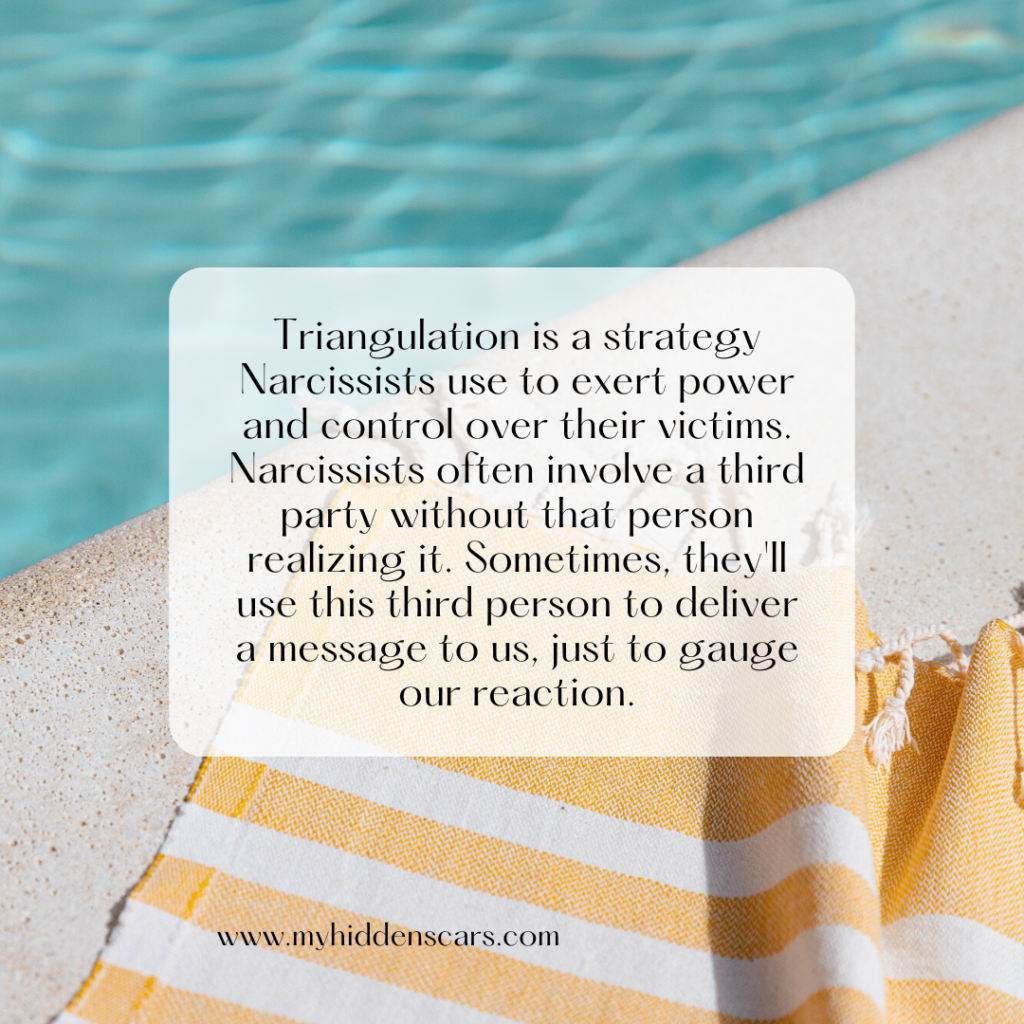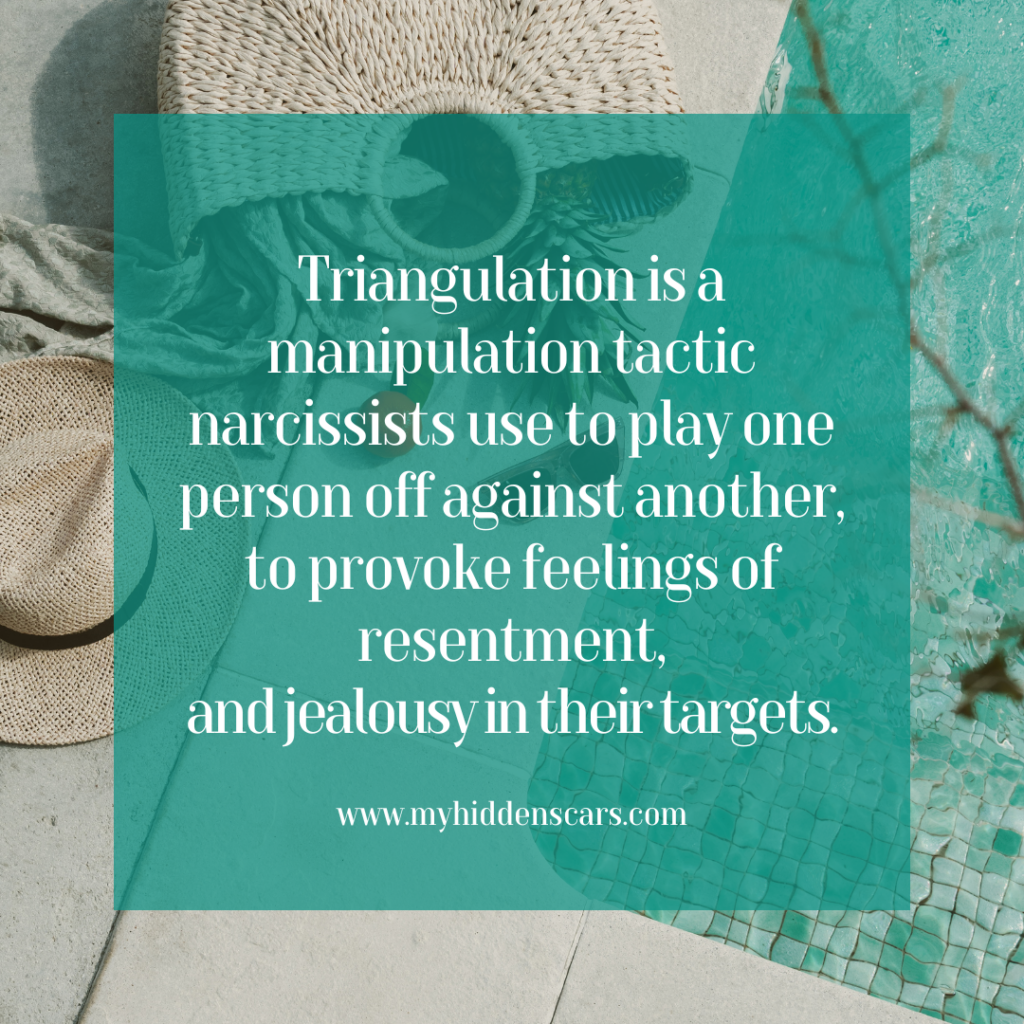When I was in the throes of my marriage, there were so many little things that went on that I had no idea were abusive. All I knew was that I was hurting; I couldn’t understand why my husband, no less my friends, and even the world were against me. I couldn’t understand why the way I saw, heard, or understood things was so different from everyone else’s, well, at least according to my husband.
In the depths of abusive relationships lie complex manipulation tactics, with triangulation being one of the most subtle yet impactful. This method not only confuses and isolates victims but also deeply entrenches unhealthy power dynamics. In this post, my goal is to shed light on triangulation, helping those affected to identify, understand, and navigate this manipulation more effectively.

What is Triangulation?
Triangulation in the context of abusive relationships is a sophisticated and insidious form of manipulation. At its core, it involves the abuser strategically using other people as tools to increase their control and influence over the victim, often without the other person’s knowledge of being used in this way. This tactic is complicated and can deeply affect the victim’s perceptions of themselves and their relationships with others, ultimately isolating and disempowering them.
How Triangulation Works:
1. Creating Doubt: By involving others, the abuser creates situations where the victim hears different versions of statements, intentions, or events that contradict their own experiences or feelings. This may lead the victim to doubt their memory, perceptions, and sanity, often called gaslighting.
2. Misinformation and Lies: The abuser might spread untrue or outright lies about the victim to friends, family, or others. For example, the abuser could suggest the victim is mentally unstable, unfaithful, or an incompetent parent. This not only alters how others perceive the victim but also can drastically reduce the victim’s support network, increasing their dependency on the abuser.
3. Gatekeeping Relationships: The abuser may gatekeep the victim’s relationships, controlling or monitoring interactions with others. They might relay what friends or family supposedly think about the victim, which can be entirely fabricated or taken out of context. This manipulation makes the victim feel judged and unsupported, further isolating them.
4. Conflicting Messages: Through the abuse of communication with others, the abuser can send conflicting messages, making it difficult for the victim to know what to believe. This could involve the abuser behaving one way in private and another in public or manipulating situations so that the victim appears to be the aggressor or at fault in conflicts.
5. Enhancing Isolation: By creating situations where the victim feels they cannot trust those around them, the abuser enhances the victim’s isolation. The victim may withdraw from friends and family because of the fear of misjudgment or more conflict, leaving them more vulnerable to the abuser’s control.
Personal Reflection:
From my own journey, I know firsthand how confusing and isolating triangulation can be. For years, I couldn’t understand why I felt like I was always the problem. I believed I was a bad partner and a bad mother simply because it seemed like everyone around me shared this view, which my ex-husband carefully crafted. It wasn’t until I learned about triangulation that I understood these feelings weren’t a reflection of my true self but were lies planted by someone who wanted to control me.
Many victims don’t realize they are being triangulated. They may feel increasingly isolated, misunderstood, and filled with self-doubt, often internalizing the blame for the problems in their relationship. The realization that their social circles—once sources of validation and support—have been compromised can lead to overwhelming confusion and emotional turmoil.
Understanding that these feelings result from a manipulative tactic, not a true measure of your character or abilities, is crucial to healing. Recognizing the signs of triangulation can empower you to find the right support and begin the journey back to trusting yourself and reclaiming your life.

Expanded Forms of Triangulation:
Manipulating Perceptions: Abusers may lie or share misleading information about the victim to friends, family, or professionals, painting themselves as the victim and the actual victim as the perpetrator. This not only isolates the victim but can also lead to loss of support networks and community standing.
Alliance Building: Abusers often manipulate relationships to create alliances against the victim. They skillfully convince others that the victim is the source of problems, aligning friends and family with their perspective. This tactic not only undermines the victim’s support system but also reinforces the abuser’s control by isolating the victim further within their social circle.
Relay Communication: Abusers use a third party to relay messages, which can be changed to cause conflict between the victim and the third party, isolating the victim even more and controlling how information is understood.
Gatekeeping Information: By controlling what the victim knows about what others think of them or the information others receive about the situation, abusers maintain a hold over the narrative surrounding the relationship, often portraying themselves in a positive way.
Validation-Seeking: Abusers often bring in external parties—such as counselors or mutual friends—to side with them, using these individuals’ authority or credibility to validate their own actions and discredit the victim.
Effects of Triangulation: Understanding the Emotional Toll
Triangulation in abusive relationships can leave a heavy emotional toll, often leaving victims feeling helpless, confused, and very isolated. This manipulation tactic not only worsens the trauma associated with abuse but also significantly distorts the victim’s sense of reality. Here’s a detailed look at these effects:
Eroding Trust
Triangulation severely undermines trust, which is crucial for any healthy relationship. When an abuser uses third parties to share information or to spread lies, it skews the victim’s ability to trust those they once confided in. Victims might hear second-hand comments or exaggerated criticisms supposedly from friends or family, which the abuser strategically manipulates to seed doubt. This manipulation makes it difficult for victims to see the difference between truth and manipulation, leading to a sense of betrayal and confusion.
Creating Isolation
Isolation is a key goal of triangulation, making sure the victim feels alone and unsupported. By manipulating communications or spreading misinformation, the abuser paints a picture of a world where everyone agrees with them and not the victim. For example, an abuser might tell the victim that their own family agrees with the abuser’s perspectives or criticisms. This creates a situation where the victim feels that reaching out for help would be useless because they perceive everyone as aligned with the abuser.
Distorting Reality
Reality distortion is a basic characteristic of triangulation. This happens when the abuser’s manipulations so heavily influence the victim’s perception of events, conversations, and relationships that their ability to make decisions or judge situations is impaired. Over time, this can lead to great psychological distress, including depression, anxiety, and a phenomenon known as gaslighting, where the victim’s reality is so manipulated that they question their sanity.
Inducing Helplessness and Dependency
The erosion of trust and isolation feeds into helplessness and dependency. Victims may feel that there is no way out of their situation because they have come to believe that the abuser is the only person they can count on or that without the abuser, they are utterly alone. This dependency is emotionally crippling and often prevents the victim from taking action to escape the abuse, as they fear the unknown more than the familiar pain.
Challenges in Seeking Help
The overall impact of triangulation seriously complicates efforts to find help. The victim may struggle with who to trust, how to share their experiences, and fear of not being believed if they do reach out. Suppose the abuser has been successful in convincing others that the victim is unstable or unreliable. In that case, the victim may face doubt or outright disbelief when they attempt to share the abuse.

Identifying Triangulation: Key Signs and Insights
Triangulation can be challenging to detect, especially when someone is not familiar with the concept. Recognizing the signs is important in breaking the cycle of abuse. Here’s a more detailed look at the indicators of triangulation:
Consistent Negative Feedback from Multiple Sources
One of the most telling signs of triangulation is receiving similar negative feedback from several people. This might happen when friends, family members, or coworkers suddenly start expressing concerns about your behavior or decisions, which aligns with the abuser’s narrative. If you notice that the criticisms share a common theme that doesn’t seem to reflect your true self but an image portrayed by the abuser, it could be a sign of manipulative communication.
Feelings of Isolation Created by Rumors or Lies
Triangulation often involves the abuser spreading rumors or lies to isolate the victim. This can manifest as friends withdrawing or cooling off their interactions based on misinformation. You might hear from other friends that others are upset with you, or you might not be invited to social gatherings without clear reasons. The isolation feels compounded when it seems everyone believes something about you that isn’t true, leaving you feeling unsupported and alone.
Sabotage of Personal Relationships
Another significant indicator is the sabotage of personal relationships. If you find that your relationships are deteriorating and misunderstandings are frequent, consider whether these are occurring naturally or if the abuser’s interference might fuel them. The abuser may twist your words or intentions when relaying them to others, or they might tell you that others have said negative things about you, which causes conflicts and distrust with people you care about.
Discrepancies in Stories and Information
Pay attention to discrepancies between what you are told and what you know to be true. If you often hear about your supposed actions or words that don’t match with your own memories or intentions, this might be a deliberate tactic to make you question your reality. This is often part of broader gaslighting strategies to undermine your self-confidence and judgment.
Increased Dependence on the Abuser
A subtle but powerful sign of triangulation is when you find yourself becoming increasingly dependent on the abuser for validation or information. If you feel like the only person you can trust or the only one who understands you is the abuser, this could be the result of intentional isolation and misinformation used to add to your dependence on them.

Coping and Getting Help: Practical Steps to Counteract Triangulation
Coping with the effects of triangulation involves both personal resilience strategies and seeking external support:
Strengthening Direct Communication
Direct communication with others is important. If you suspect triangulation, try to communicate directly with the people involved. This can help clarify misunderstandings and prevent the abuser from controlling the narrative. Keep your communications clear and document interactions when possible, which can help you keep track of the facts if your reality starts to be questioned.
Verifying Facts
Fact-checking is important. Whenever you receive information that affects your relationships or self-image, especially if it comes from or through the abuser, take time to verify it. This could include asking straightforward questions to the person directly or cross-checking stories with others.
Maintaining a Personal Support Network
Develop and maintain a support network that is separate from the abuser. This might include friends, family, colleagues, or members of support groups who understand your situation or are outside the influence of the abuser. Having a reliable group can provide emotional support and a reality check when you need it.
Seeking Professional Help
Professional help can be extremely helpful. Therapists, especially those experienced in dealing with domestic abuse, can offer guidance, coping strategies, and a safe space to express and understand your feelings and experiences. They can also help you rebuild your self-esteem and regain trust in your perceptions.
Conclusion: The Power of Understanding Triangulation
Triangulation is a horrible tool used by abusers to isolate and manipulate their victims. By understanding its mechanisms and manifestations, victims and bystanders can take significant steps toward dismantling the power it holds. Recognizing the signs of triangulation empowers those affected to seek the right kind of help and begin the journey toward healing and autonomy.
We can better identify and intervene in these destructive patterns through education and awareness, offering meaningful support to those in need. Triangulation thrives in silence and secrecy; by bringing light to these tactics, we can help break the cycle of abuse and support victims in reclaiming their lives.
Call to Action: If you or someone you know is experiencing the effects of triangulation in an abusive relationship, remember that you are not alone. Reach out to trusted individuals, seek professional guidance, and consider connecting with support groups. As a divorce coach specializing in helping individuals navigate the complexities of abusive relationships, I am here to offer support and strategies to empower you during this challenging transition. Sharing your story can also inspire and help others in similar situations. Let’s continue to educate and support each other in our communities.




